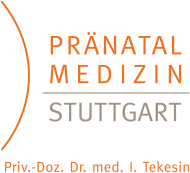FAQ – Frequently asked questions
Expectant parents often wonder whether and how much your child hears of feels the ultrasound or if it could be damaged by the ultrasound.
Ultrasound is a sound wave which generates mechanical effects and temperature increases in the tissues it passes through. The frequency of diagnostic ultrasound is around 5 to 10 megahertz, which is equivalent to 5 to 10 million vibrations per second.
The acoustic (hearing) range of the human ear extends only from about 16 to 20,000 Hertz maximum. Some animals, for example mice, dogs, dolphins and bats, can hear substantially higher frequencies such as ultrasound. However, your baby cannot hear the ultrasonic waves.
The ultrasound is not generated continuously during the scan, but is released in a short, rapid succession of pulses. It has not been proven that this pulse repetition rate leads to an acoustic phenomenon in the unborn child.
There is also no risk that the baby is dangerously warmed by the prenatal ultrasound scan. A temperature increase of up to 4 °C has only been produced in animal tests using prolonged pulsed Doppler scans which lasted for several minutes. This special ultrasound method is only used in antenatal care when the ultrasound specialist examines the cardiovascular system of the fetus. However, this scan only takes a few seconds, and it does not lead to relevant local temperature increase.
Although there is currently no evidence that ultrasound can lead to of damage to the fetus, the so-called ALARA principle ("as low as reasonably achievable") applies to ultrasound diagnostics: as much as necessary, as little as possible.
The sex of the unborn child can be determined with high reliability during the 2nd ultrasound screening. However, you should remember that determination of the sex of the baby is not an obligatory part of prenatal care.
Experienced ultrasound specialists can reliably detect the baby’s sex relatively well in the 12th week of pregnancy. However, we can only inform you of the baby’s sex after the 14th week of pregnancy, i.e. from 14 + 0 weeks (German Gene Diagnostics Law).
More and more patients are interested in the possibilities of 3D / 4D ultrasound and the main reason for this is the fascinating images. We view this modern method primarily as supplementary measure in special cases. For this reason, we use 3D / 4D technology especially when we can expect it to provide additional diagnostic information under the available examination conditions. We do not perform a 3D / 4D scan without reason as part of routine diagnostics.
These additional procedures are not listed in the service catalogue of the health insurance companies (Krankenkassen) as part of prenatal care. This additional scan can be performed if you agree to cover the cost yourself; however we only perform this scan if there is a previous malformation diagnosis.
After the scan you will receive some 2D images. Your local obstetrician and gynaecologist (Frauenarzt) will also be sent a written report. A video recording is only intended for medical documentation and therefore cannot be provided to take home.
During the investigation, we concentrate entirely on you and your unborn child. We therefore kindly ask you not to bring young siblings to this very demanding investigation. Unfortunately, we do not have any childcare facilities on our practice at the moment.
Please bring your pregnancy record (“Mutterpass”), any previous diagnoses and doctors’ letters, your health insurance card and, if appropriate, a valid referral form for treatment with you.
